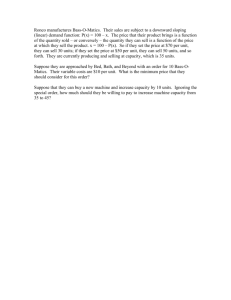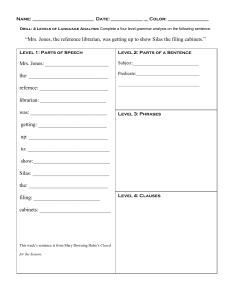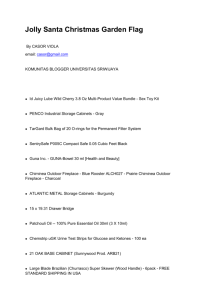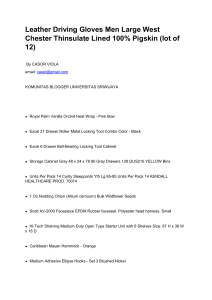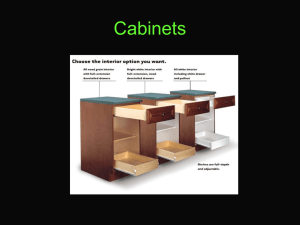PowerPoint
advertisement
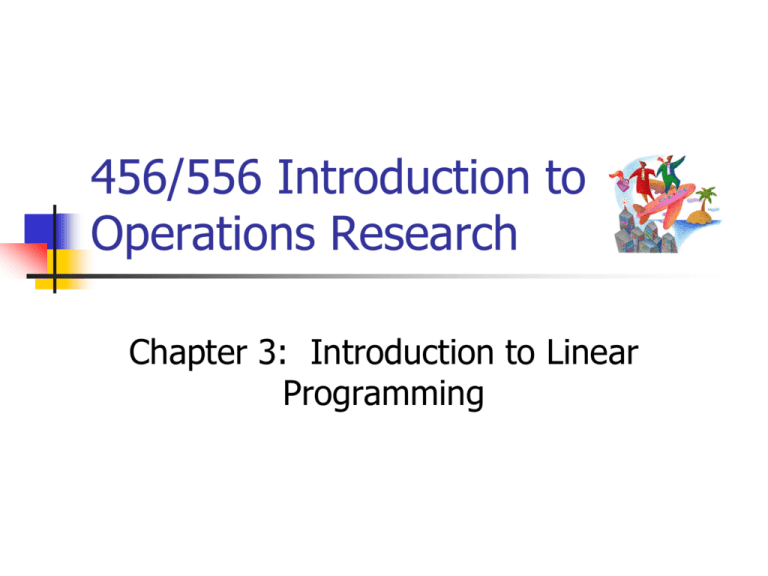
456/556 Introduction to Operations Research Chapter 3: Introduction to Linear Programming Linear Programming In order to solve OR problems, we need to turn a real-world problem into a mathematical model. One of the most important models (due to its usefulness in solving a variety of problems) is the linear programming model. This type of model is used to address the general problem of allocating limited resources among competing activities in a best possible (optimal) way. All mathematical functions in linear programming models are linear. We now look at some simple examples of linear programming models that can be solved graphically. 2 456/556 Introduction to Operations Research 3.1: Prototype Examples Example 1 (File Cabinets) An office manager needs to purchase new filing cabinets. She knows that Ace cabinets cost $40 each, require 6 square feet of floor space, and hold 24 cubic feet of files. On the other hand, each Excello cabinet costs $80, requires 8 square feet of file space, and holds 36 cubic feet. Her budget permits her to spend no more than $560 on files, while the office has space for no more than 72 square feet of cabinets. The manager desires the greatest storage capacity within the limitations imposed by funds and space. How many of each cabinet should she buy? 4 Example 1 (cont.) We can formulate this situation as a linear programming problem. Let x1= the number of Ace cabinets to be bought. Let x2 = the number of Excello cabinets to be bought. Let Z = the total storage capacity of cabinets purchased. Summarize the given information in a table: 5 Example 1 (cont.) Resource usage per cabinet Cabinet type Amount of Resource Available Resource Ace Excello Cost $40 $80 $560 Floor space 6 sq ft 8 sq ft 72 sq ft Storage space 24 cu ft 36 cu ft 6 Example 1 (cont.) We call x1 and x2 decision variables for this model. From the bottom row of the table, we get the objective function: Z = 24 x1 + 36 x2 (1) The objective function gives the amount of storage space in cubic feet for a choice of x1 and x2. In this case, the objective is to maximize Z. 7 Example 1 (cont.) From rows 1 and 2 of the table, we get restrictions on our choices of x1 and x2 due to a limit on what we can spend and the size of the office. 40 x1 + 80 x2 ≤ 560 (2) 6 x1 + 8 x2 ≤ 72 (3) We also want x1 ≥ 0 (4) x2 ≥ 0 (5) The last two restrictions on x1 and x2 make sense physically. We call equations (2) - (5) constraint equations. 8 Example 1 (cont.) Our model for deciding how to allocate file cabinets is as follows: Maximize: Z = 24 x1 + 36 x2 Subject to the restrictions: 40 x1 + 80 x2 ≤ 560 (cost) 6 x1 + 8 x2 ≤ 72 (space) and x1 ≥ 0; x2 ≥ 0. 9 Example 2 (Feeding Laboratory Animals) Certain laboratory animals must have at least 30 grams of protein and at least 20 grams of fat per feeding period. These nutrients come from food A, which costs 18 cents per unit and supplies 2 grams of protein and 4 of fat; and food B, which costs 12 cents per unit and has 6 grams of protein and 2 of fat. Food B is bought under a long-term contract requiring that at least 2 units of B be used per serving. How much of each food should included in a serving to produce the minimum cost per serving? 10 Example 2 (cont.) Again, we can formulate this situation as a linear programming problem. Let x1= units of food A per serving. Let x2 = units of food B per serving. Let Z = the cost per serving of food. As before, summarize the given information in a table: 11 Example 2 (cont.) Nutrient per serving Food type Amount of Nutrient Required Nutrient A B Protein 2 gm 6 gm 30 gm Fat 4 gm 2 gm 20 gm Cost 18 cents 12 cents 12 Example 2 (cont.) The linear programming model for this case is as follows: Minimize: Z = 18 x1 + 12 x2 Subject to the restrictions: 2 x1 + 6 x2 ≥ 30 (protein) 4 x1 + 2 x2 ≥ 20 (fat) and x1 ≥ 0; x2 ≥ 2. 13 The Graphical Method For linear programming problems involving two decision variables, we can solve by graphing linear inequalities! For more than two variables, we will have to resort to other methods, such as the Simplex Method, which we will see in Chapter 4. 14 The Graphical Method (cont.) The basic idea of this method is to sketch a graph of all ordered pairs of decision variables (x1, x2) that satisfy all given constraint equations. The set of all valid pairs of decision variables (x1, x2) is called the feasible region. Once the feasible region is found, we look for the pair(s) (x1, x2) that maximize (or minimize) the objective function. 15 Example 1 (cont.) Let’s apply the graphical method to this linear programming problem for filing cabinet choices: Maximize: Z = 24 x1 + 36 x2 Subject to the restrictions: 40 x1 + 80 x2 ≤ 560 (cost) 6 x1 + 8 x2 ≤ 72 (space) and X1 ≥ 0; x2 ≥ 0. 16
